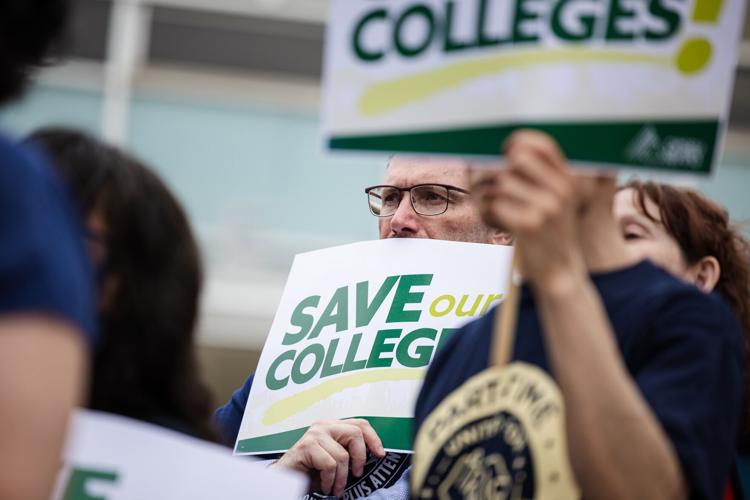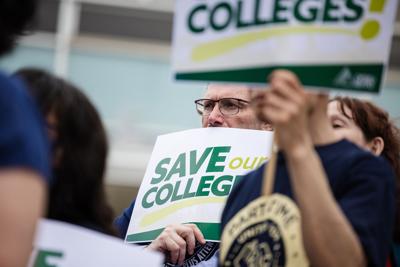In the wake of what’s been described as the largest mass layoff in Ontario’s history — with 10,000 staff let go and more than 600 programs cut at public colleges — an analysis reveals that one-third of the affected programs are in business and management, while nearly a quarter fall under engineering, technology and applied science.
Programs in the arts and media make up 14 per cent, with health sciences and wellness at seven per cent, and hospitality, culinary and tourism at six per cent, according to a É«É«Ŕ˛ Star breakdown of union data.
The Ontario Public Service Employees Union recently shared a list of the suspended or cancelled programs at each public college stretching back to April 2024, providing the first comprehensive look at the widespread academic impact of a post-secondary funding crisis made worse by a sharp decline in international enrolment.
While the cuts largely reflect where international students have been concentrated —  — the fallout extends well beyond that, with few areas of study spared.
Programs axed include paramedic training, wastewater technician, musical theatre, brick masonry, machining, nursing, emergency dispatch, urban forestry, hotel management, palliative care, law clerks, massage therapy, energy auditing, jewelry arts, electrical engineering, baking and early childhood education, just to name a few. Some 16 honour bachelor degrees have also been cancelled or are not taking in new students this fall.
OPSEU shared news of the layoffs and program cuts last week — just after an arbitration ruling upheld the union’s self‑collected data.
“The human toll of this is massive,” OPSEU/SEFPO president JP Hornick told the Star ahead of last Wednesday’s news conference where the union vowed to “fight back.” Alleging mismanagement, Hornick claimed the federal cap on study permits was being used as “an excuse to downsize programs that have nothing to do with international enrolment.”
According to the union, 913 full-time and 4,049 part-time and sessional faculty have been let go, as well as 3,734 support and administrative staff. The union suggests the total job loss is higher as some numbers were kept confidential in the mediation process and a handful of colleges did not report their totals.
Of the province’s 24 public colleges, roughly nine have suspended more than a quarter of their programming, with smaller institutions like Loyalist in Belleville and St. Lawrence in Kingston taking the biggest hits.
St. Lawrence president and CEO Glenn Vollebregt said the college has had to reimagine itself in “response to factors beyond our control,” including “having to reduce how many programs we offer even though the training we deliver and the graduates we produce are integral to the regions and employers we serve across Ontario.”
St. Lawrence has suspended 36 programs — 40 per cent of offerings — and, as a result, will have 5,000 fewer students.
Post-secondary layoffs and program cuts — spread across 24 public colleges — have hit both urban
A Loyalist spokesperson confirmed that college has in response to “multiple factors, including evolving enrolment patterns, shifting policy and financial sustainability,” adding that currently enrolled students will be fully supported to graduation.
In the Greater É«É«Ŕ˛ Area, colleges such as Sheridan and Centennial have been among the most affected.
Sheridan has been as a result of “dramatic shifts in government policy, economic pressures, and social and technological disruptions.
“We had to make difficult decisions about our academic programming and college operations to ensure we continue to meet the needs of our students, industry and the communities we are a part of,” said a college spokesperson, noting that the school is, however, adding 10 new programs this fall to “meet student and industry demand.”
Centennial, which was one of the colleges singled out at the OPSEU news conference, said the figures shared by the union are incorrect. Spokesperson Michelle Ervin said the school has but looks forward “to welcoming new cohorts of students to the more than 100 labour-market aligned programs that the college continues to offer.”
She added that “external pressures — including federal policy changes affecting international students and a fundamentally broken funding model — have impacted both domestic and international learners, regardless of a program’s enrolment makeup.”
Some critics have characterized the upheaval in the college sector as a “right-sizing” of the unchecked growth of international students, alleging that cuts are targeting low-skilled programs primarily seen as pathways to permanent residency.
However, colleges have argued the fallout, which is being felt in nearly all 200 communities across Ontario where public colleges have campuses, will affect both domestic students and local economies.Â
St. Lawrence’s Vollebregt says his college has taken “a controlled and measured approach to growing international enrolment as a means of covering funding shortfalls,” and “for programs where domestic student enrolment was not enough to make a program financially sustainable, SLC recruited international students to increase the diversity and stability of the program.”
At George Brown in É«É«Ŕ˛, the suspension of three of its four highly regarded jewelry and gemmology programs left domestic student Alexus Arnold scrambling. The 17-year-old from Port Colborne, Ont., had applied to the three-year jewelry arts program and the college’s jewelry methods program and gemmology as backups only to be told they were all suspending the intake of new students this fall.
“I was absolutely crushed; this was my dream,” said Arnold, who will instead be studying business at Seneca Polytechnic in the fall and hoping to still have her own jewelry line one day. “I have wanted to do this since I was 11.”
Meanwhile, this summer, Georgian College has had to pause intake into its Power Engineering Technology program at its Owen Sound campus. The program, which trains people to work in such places as gas compression plants or food processing, usually draws up to 75 per cent domestic students. However, it was not deemed eligible for a post-graduation work permit, which has hurt international enrolment, according to Georgian president and CEO Kevin Weaver.
“The program requires a higher overall number of students across multiple intakes and a mix of domestic and international students to remain viable,” he said.
“As you can imagine, given energy is a top provincial priority, central to economic growth and development, access to a sustained talent pool will be critical. Impacts of diminished enrolment in this program will soon be felt across multiple sectors.”






























To join the conversation set a first and last name in your user profile.
Sign in or register for free to join the Conversation